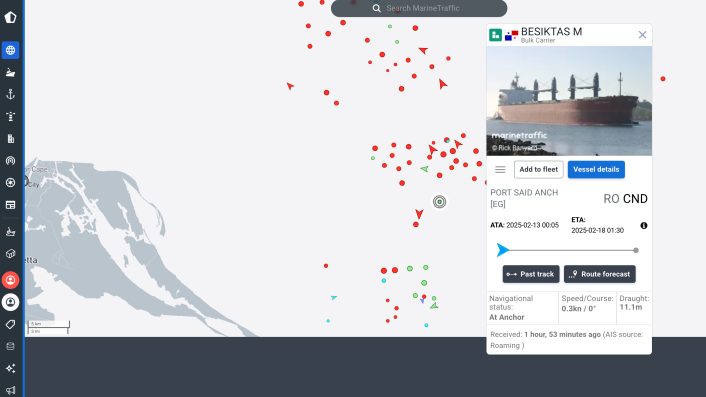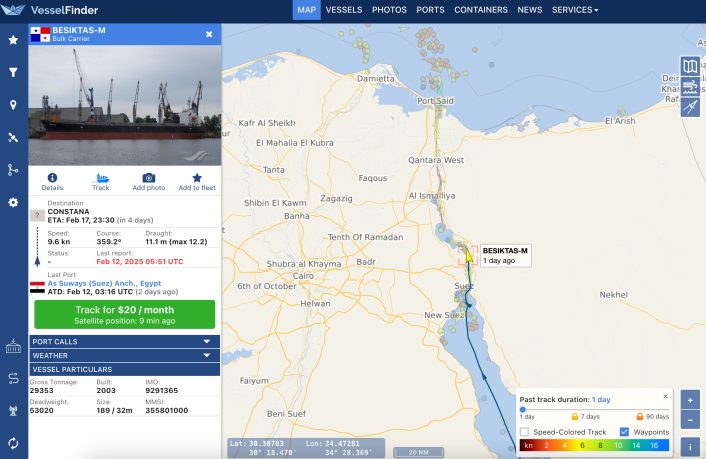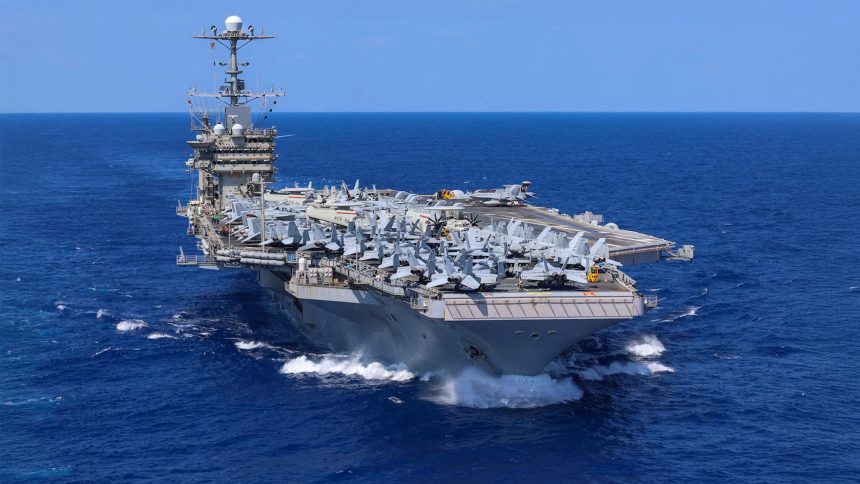The Nimitz-class aircraft carrier USS Harry S. Truman collided with the merchant vessel Besiktas-M near Port Said, Egypt, in the Mediterranean Sea.
USS Harry S. Truman (CVN 75), was involved in a collision with a merchant ship in the Mediterranean Sea, off Egypt, on Feb. 13, 2025.
Here’s the official statement by U.S. Naval Forces Europe and Africa / U.S. Sixth Fleet:
The Nimitz-class aircraft carrier USS Harry S. Truman (CVN 75) was involved in a collision with the merchant vessel Besiktas-M at approximately 11:46 p.m. local time, Feb. 12, while operating in the vicinity of Port Said, Egypt, in the Mediterranean Sea.
The collision did not endanger the Harry S. Truman (CVN 75) as there are no reports of flooding or injuries. The propulsion plants are unaffected and in a safe and stable condition. The incident is under investigation. More information will be released as it becomes available.
The position of the aircraft carrier and merchant vessel off Port Said can be determined by means of AIS on ship tracking website Marine Traffic.
Current positions for the Besiktas-M and CVN-75 (highlighted) via @MarineTraffic
Source- https://t.co/ZsTHbjmc2M pic.twitter.com/MPXHwokF9G
— OSINTtechnical (@Osinttechnical) February 13, 2025
The merchant ship appears to be at anchor now. Her status is unknown at the time of writing.

Besiktas-M is a bulk carrier registered under the flag of Panama and managed by Synergy Ship Management Turkey. AIS data shows the vessel transited through the Suez Channel on Feb. 12, 2025.

The aircraft carrier, with its Carrier Air Wing (CVW) 1 with nine embarked aviation squadrons, is the flagship of the USS Harry S. Truman Carrier Strike Group (HSTCSG) consisting of Destroyer Squadron (DESRON) 28; the Ticonderoga-class guided-missile cruiser, USS Gettysburg (CG 64); and two Arleigh Burke-class guided-missile destroyers, USS Stout (DDG 55) and USS Jason Dunham (DDG 109), entered the U.S. Central Command (USCENTCOM) area of responsibility.
In mid-December 2024, the HST CSG, entered the CENTCOM AOR, conducting various missions, including multiple strikes against Iranian-backed Houthis, who had attacked U.S. Navy warships and merchant vessels in the southern Red Sea and Gulf of Aden. On Feb. 1, HSTCSG conducted airstrikes against ISIS-Somalia in support of U.S. Africa Command and in coordination with the Federal Government of Somalia.
USS Harry S. Truman transitioned into the Mediterranean Sea on Feb. 3 and arrived in Souda Bay, Greece, on Feb. 6 after spending 50 days in the Red Sea, according to USNI News.
“The Harry S. Truman Carrier Strike Group remains the most adaptable and lethal presence in theater,” said Rear Adm. Sean Bailey, commander, HSTCSG. “This port visit provides the opportunity to reset and focus on maintenance for maximum readiness ahead of future operations.”
The carrier was escorted to its port call in Souda by USS Jason Dunham (DDG-109) while USS The Sullivans (DDG-68), also in the Mediterranean Sea, did not stop at the port, per a Navy official. USS Stout (DDG-55) and USS Gettysburg (CG-64) remain in the Red Sea.
The transit into the Mediterranean Sea marked the third instance in over 15 months where no U.S. aircraft carrier is present in the Red Sea: the last time was in November when the Abraham Lincoln Carrier Strike Group exited the region. Four destroyers maintained U.S. presence until the Truman Carrier Strike Group arrived.
The U.S. has maintained a carrier strike group in the Middle East since November 2023, following the Oct. 7 Hamas attacks and Israel’s subsequent actions in Gaza. The Houthis began targeting Red Sea shipping amid the conflict. Since the ceasefire between Israel and Hamas, the Houthis have paused their attacks on merchant and Navy vessels but continue their disinformation efforts against the U.S., including a recent museum exhibit depicting an aircraft carrier explosion.
Last month, a spokesperson for Yemen’s Houthi militants claimed that their forces conducted a 9-hour attack on the USS Harry S. Truman and its carrier strike group. According to the Houthis, the assault involved cruise missiles and drones, allegedly forcing the carrier to retreat to the northern Red Sea.
However, U.S. CENTCOM did not confirm the attack. Instead, they released a photo showing the Truman sailing in the Red Sea alongside the USS Jason Dunham and USS Gettysburg, signaling no disruption to their operations.
Anyway, considering that the transit through the Suez Canal was completed on Feb. 3 and the carrier arrived in Souda Bay on Feb. 6, it’s not clear at the moment why USS Harry Truman was again off Port Said, where the collision with Besiktas-M occurred. Considering that Port Said is located at the northern entrance of the Suez Canal, on the Mediterranean coast, at the canal’s mouth, where ships enter or exit the Suez Canal from the Mediterranean Sea, was the aircraft carrier heading back towards the Red Sea?
Collisions at sea
Collisions involving warships and merchant ships are quite rare. In 2021, the French Navy’s flagship, the aircraft carrier Charles de Gaulle, collided with a 10-meter Polish-flagged sailboat while training off the coast of Toulon.
The Charles de Gaulle failed to spot the sailboat until it was very close, just before 7:30 AM. Despite an emergency maneuver to avoid the vessel, and no apparent reaction from the sailboat, the two collided around 7:30 AM, with the sailboat striking the carrier’s hull.
The crew of Charles de Gaulle immediately took action to check for any casualties. They made radio contact with the skipper and sent an assistance team to the sailboat. It was confirmed that only one person was on board and the vessel was not taking on water, although the collision did cause the sailboat’s mast to break.
A worse outcome had the collision between the U.S. Navy destroyer John S McCain and the Liberian-flagged tanker Alnic MC in 2017.
Here’s an abstract from the NTSB report on the incident:
On August 21, 2017, the US Navy destroyer John S McCain was overtaking the Liberian-flagged tanker Alnic MC while both vessels were transiting the westbound lane in the Middle Channel passage of the Singapore Strait Traffic Separation Scheme. The destroyer crew had a perceived loss of steering, and, while the crew attempted to regain control of the vessel, the John S McCain unintentionally turned to port into the path of the Alnic MC. At 0524, the vessels collided. As a result of the collision, 10 John S McCain sailors died, 48 were injured, and the vessel sustained over $100 million in damage. No one was injured on the Alnic MC, and the vessel sustained about $225,000 in damage. There was no report of pollution.
The National Transportation Safety Board determines that the probable cause of the collision between the destroyer John S McCain and the tanker Alnic MC was a lack of effective operational oversight of the destroyer by the US Navy, which resulted in insufficient training and inadequate bridge operating procedures. Contributing to the accident were the John S McCain bridge team’s loss of situation awareness and failure to follow loss of steering emergency procedures, which included the requirement to inform nearby traffic of their perceived loss of steering. Also contributing to the accident was the operation of the steering system in backup manual mode, which allowed for an unintentional, unilateral transfer of steering control.
Safety issues identified in this accident included the following:
- The decision to transfer the location of thrust control on board the John S McCain while the vessel was in a congested waterway
- The lack of very high frequency radio communications between the vessels
- The automatic identification system data transmission policy for Navy vessels
- The procedures for the transfers of steering and thrust control on board the John S McCain
- The training of Navy bridge watchstanders
- The design of the destroyer’s Integrated Bridge and Navigation System
- Navy watchstanders’ fatigue
- Navy oversight of the John S McCain
A few weeks earlier, on June 17, 2017, the U.S. Navy destroyer USS Fitzgerald collided with the Philippine-flagged container ship MV ACX Crystal about 80 nautical miles southwest of Tokyo, near Shimoda on Japan’s Honshu coast.
Seven sailors from the Fitzgerald died, their bodies recovered from flooded berthing compartments. At least three others were injured, including the ship’s commanding officer, Commander Bryce Benson.
Investigations into the USS Fitzgerald collision revealed a series of errors by the crew and failures to act in the minutes before impact. A lack of situational awareness on the bridge made it impossible to avoid the collision even after the container ship was spotted. Following the incident, the ship’s top two senior officers and the senior enlisted sailor were relieved of duty and faced criminal charges, which were later dropped. Around a dozen other crew members received non-judicial punishments. The investigation also highlighted issues with the ship’s radar system, which was not working correctly at the time. The Navy later acknowledged that overly complex touchscreen controls contributed to the accident, leading to a decision to replace them with traditional wheels and throttles on all ships.
The owners of the container ship agreed to pay $27 million in compensation to the U.S. Navy.
In July 2004, USS John F. Kennedy collided with a dhow in the Persian Gulf, resulting in the loss of all aboard the small vessel. Following the incident, the carrier’s commanding officer was relieved of duty. Although the ship itself was undamaged, two jets on the deck were damaged when an F-14B Tomcat slid into an F/A-18C Hornet during a sharp turn to avoid the dhow. An investigation revealed the turn was not delayed to recover aircraft low on fuel, countering popular belief.









